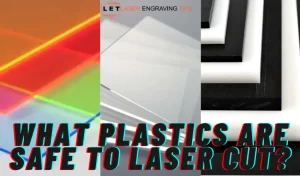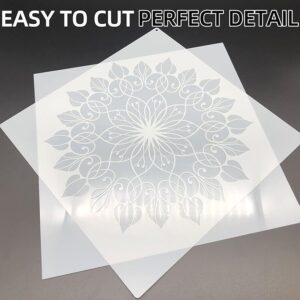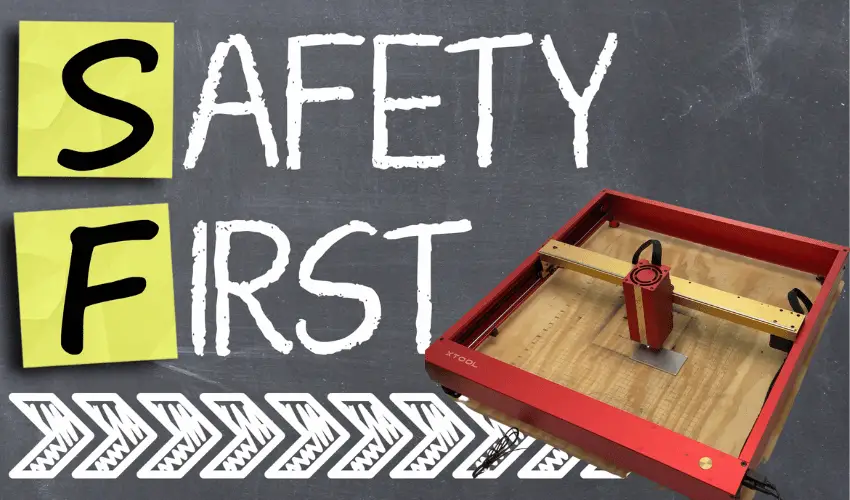Plastic is a versatile material, which gives it a wide range of applications, so what plastics are safe to laser cut? Some plastics can release toxic fumes or catch fire, while others cut cleanly and safely. In this guide, we’ll break down the safe and unsafe plastics for laser cutting, along with tips for identifying materials and staying safe.
The plastic materials that are safe to laser cut are:
- Cast Acrylic
- Extruded Acrylic
- PES Film (Polyethersulfone)
- Foam PE (Polyethylene Foam)
- Polyamide (PA, Nylon)
- Polybutylene Terephthalate (PBT)
- Polyethylene Terephthalate (PET, e.g., Mylar)
- Polyimide (PI, e.g., Kapton®)
- Polyoxymethylene (POM, e.g., Delrin®)
- Polyphenylene Sulfide (PPS)
Table of Contents
What Plastics Are Safe To Laser Cut?

These plastics are commonly used with CO₂ and Diode laser cutters and are considered safe when proper ventilation is used.
1. Acrylic
Acrylic (lucite/plexiglass/PMMA) is one of the top materials for laser cutting. It cuts nice and safely, producing a fine polished edge.
There are two types of acrylic materials: extruded and cast. Both are ideal for laser processing, but they respond differently to laser cutting. Extruded acrylic cuts smoothly and leaves a clean, flame-polished edge. In addition, it is less expensive than cast acrylic. It is therefore the best acrylic type for laser cutting.
Cast acrylic also cuts nicely under a laser beam, but it does not produce a polished edge. It produces a white frosty color under laser processing. It is therefore more suitable for laser engraving.
When cutting acrylic, high power and slow speed produce the best results. This ensures that the laser beam melts the edges and creates a smooth edge. The process is perfectly safe, but you should wear protective gear to protect against any fumes.
Cast Acrylic (PMMA)
- Laser Behavior: Cuts very cleanly; engraves with high contrast.
- Use Cases: Signage, displays, awards, jewelry.
- Note: Preferred over extruded acrylic for engraving.

Extruded Acrylic
- Laser Behavior: Cuts well with polished edges.
- Use Cases: Cost-effective option for cutting projects.
- Note: Not ideal for detailed engraving due to lower clarity.
2. PES Film (Polyethersulfone)
PES film has excellent resistance to heat, which means it can withstand the localized heat of a laser beam without melting uncontrollably or igniting. This makes it ideal for precise, clean cuts. It vaporizes cleanly when lasered, producing minimal charring or debris. This results in smooth edges with minimal discoloration, especially in thin films.
PES films are manufactured with a smooth, even surface and consistent thickness, which improves laser focus and beam interaction, leading to reliable and repeatable cutting results. Compared to some other polymers, PES has low flammability, which reduces the risk of flare-ups or uncontrolled burning during cutting.
PES is often used in filtration membranes, insulation, and electronics, where precise, non-contact cutting is essential—further justifying its compatibility with laser processing. While it may release some fumes during cutting, they are not as harmful as those from materials like PVC or ABS. Proper ventilation is still required, but it’s generally considered safe under normal laser cutting conditions.
- Laser Behavior: Thin and heat-resistant, cuts cleanly with minimal discoloration.
- Use Cases: Electrical insulation, filtration membranes.
- Note: Ensure proper ventilation due to potential fumes.
3. Foam PE (Polyethylene Foam)
PE foam has a relatively low melting point, allowing the laser to cleanly vaporize the material rather than burning or charring it. This produces neat cuts with minimal residue, especially in thinner foam sheets.
When properly ventilated, cutting PE foam generates low levels of smoke and non-toxic fumes compared to plastics like PVC or ABS. This makes it safer for both the user and the laser machine. The consistent, closed-cell structure of PE foam ensures even laser penetration, reducing the chances of uneven cuts or melting.
Many types of laser-grade PE foam are treated to be flame-retardant or self-extinguishing, reducing the risk of flare-ups during cutting. Because it’s lightweight and low-density, PE foam can be easily cut with low- to mid-powered CO₂ lasers (30W–60W), making it accessible for hobbyists and small workshops.
PE foam is widely used for tool inserts, custom packaging, and padding—all applications that benefit from the precision and customizability of laser cutting.
- Laser Behavior: Cuts easily with low power settings; produces minimal charring.
- Use Cases: Packaging, padding, modeling foam.
- Note: Thin sheets cut better; thicker pieces may melt.
4. Polyamide (PA, Nylon)
Polyamide (PA)—commonly known as nylon—can be suitable for laser cutting, especially when handled carefully and in thin sheet form. Its mechanical strength and thermoplastic nature make it a viable material for many laser applications, particularly in industrial and engineering environments.
Polyamide has a high melting point and stable thermal behavior, which allows for controlled melting and vaporization during laser cutting. This results in relatively clean cuts when using optimized settings.
PA is a tough and wear-resistant plastic, making it ideal for producing mechanical parts, gears, spacers, and fixtures via laser cutting. Its dimensional stability under laser heat also reduces deformation. While thicker nylon may melt or char, thin sheets (typically under 2–3mm) can be cut with good precision, allowing for intricate cuts in prototyping and fabrication.
PA does release noticeable fumes and odor when lasered, but it does not produce highly toxic gases like PVC or ABS. With adequate ventilation, it can be processed safely in most environments. Nylon’s high strength-to-weight ratio and resilience make it common in automotive, electronics, and tooling industries—many of which rely on laser cutting for customization and speed.
- Laser Behavior: Cuts with moderate precision but can emit odor.
- Use Cases: Gaskets, gears, mechanical parts.
- Note: Requires good fume extraction.
5. Polybutylene Terephthalate (PBT)
As a thermoplastic, PBT melts at a consistent temperature, which allows a laser to cut cleanly without uncontrolled burning or excessive deformation. This makes it ideal for precision cutting in industrial and engineering applications.
When cut with proper fume extraction, PBT generates moderate, manageable emissions, unlike materials such as PVC or ABS which release highly toxic gases. PBT retains its shape well under heat and stress, resulting in accurate and consistent cuts with minimal warping. This is especially useful in parts requiring tight tolerances, such as housings or connectors.
While thick PBT might char or discolor slightly, thin sheets (typically under 2–3 mm) respond well to CO₂ lasers, producing smooth, functional edges. PBT is commonly used in automotive, electrical, and appliance parts—areas where laser cutting is frequently used for prototyping or low-volume manufacturing.
- Laser Behavior: Cuts thin sheets well; may yellow slightly.
- Use Cases: Electrical components, housings.
- Note: Best used with low power and high ventilation.
6. Polyethylene Terephthalate (PET), e.g., Mylar

Mylar is another name for polyester film polyethylene terephthalate. It is mostly used to make stencils, as it is easy to stencil with, clean, and durable.
Mylar is a versatile plastic material that possesses high strength, durability, and high tensile properties. It is therefore an excellent material for laser cutting as it allows for a precise and clean cut.
However, while Mylar is safe and ideal for laser cutting, it does pose some challenges. First of all, the edges of the plastic can melt as you cut, resulting in burred edges. If the laser beam is too powerful, the material may catch fire. As a result, a low-power laser beam at low speeds is recommended.
Another issue with laser cutting Mylar has to do with the thickness. If the sheets are too thick, they will warp, curl, or bubble as you are cutting. On the other hand, if they are too thin, they will not hold together. So you may have to do a lot of testing before you find your sweet spot.
- Laser Behavior: Cuts cleanly in thin sheets with slight edge darkening.
- Use Cases: Packaging, enclosures, light diffusers.
- Note: PETG is often preferred over PET for smoother results.
7. Polyimide (PI, e.g., Kapton®)
Kapton (also known as polyimide) is a type of high-performance plastic polymer. The material is characterized by properties such as high electrical resistance, high thermal conductivity, and excellent tensile properties. This makes it ideal for laser cutting.
Kapton tape can be laser cut to make solder masks or stencils. It can also be used in laser marking. The material is usually cut using CO2 lasers as polyimides have excellent CO2 laser energy absorption capacity. However, UV lasers can also be used.
One major drawback of laser cutting Kapton is that the edges tend to char. Thermal damage can also occur under a too powerful laser beam. However, this can be overcome by using medium power laser beams (with thin sheets). Any charring that occurs can be easily cleaned using isopropyl alcohol.
- Laser Behavior: Cuts well in thin films; highly resistant to heat.
- Use Cases: Flexible electronics, insulation, aerospace.
- Note: Excellent for precision applications.
8. Polyoxymethylene (POM, e.g., Delrin®)

Delrin is the name used for acetal resins, a type of semi-crystalline thermoplastic polymers. These plastics are also known as polyoxymethylene (POM).
It is used in a wide range of applications such as pumps and water valve components, gears, rollers, electrical insulators, bearings, and more.
Delrin is strong, has low friction, and maintains high rigidity. It is also more ductile (compared to acrylic and wood), which allows for easier and more accurate cuts. On top of that, the laser creates a smooth, sharp-less edge that requires no additional finishing.
That said, laser cutting Delrin does come with some drawbacks. First of all, the material tends to warp, especially if stored improperly. It also produces fumes that, though not toxic, are very pungent. Furthermore, it can catch fire, especially under a powerful laser beam. It is therefore advisable to use low cutting speed and low power when laser cutting Delrin.
- Laser Behavior: Cuts very well in thin sheets with minimal melt.
- Use Cases: Mechanical parts, gears, fixtures.
- Note: Emits a formaldehyde-like smell—ensure strong ventilation.
9. Polyphenylene Sulfide (PPS)
PPS has a high melting point (around 280°C / 536°F), allowing it to withstand localized laser heat without uncontrolled melting or degradation. This enables precise and stable cuts when using a CO₂ laser. Like other thermoplastics, PPS can melt and vaporize predictably under laser exposure. With the right settings, it cuts cleanly with minimal burring or warping, especially in thinner sheets.
PPS is inherently flame-retardant and chemically inert, which reduces the risk of flare-ups during laser processing and makes it safer to handle compared to more volatile plastics. PPS offers excellent mechanical strength and does not deform easily under thermal or mechanical stress. This makes it suitable for high-precision laser-cut components, particularly in aerospace, automotive, and electronics.
While PPS does release some fumes when lasered, they are generally manageable with proper ventilation or filtration systems. It does not emit highly corrosive or toxic gases like PVC.
- Laser Behavior: High-performance thermoplastic that cuts cleanly with some residue.
- Use Cases: Automotive, electronics, chemical-resistant parts.
- Note: Suitable for precise industrial applications.
Plastics That Are NOT Safe to Laser Cut
Even if you have a powerful laser cutter, there are some plastics that you shouldn’t use for your laser cutting projects. These are;
- PVC
- Polycarbonate (PC)
- ABS (Acrylonitrile Butadiene Styrene)
- HDPE (High-Density Polyethylene)
- Fiberglass / Carbon Fiber (with epoxy)
Let’s have a look at each of these and why you shouldn’t laser cut them.
PVC
PVC (polyvinyl chloride) is the name of a versatile plastic material with numerous applications. Examples include making water pipes, drainage pipes, sewer pipes, plastic cables, floors, roofing membranes, synthetic leather, and more.
Despite having a wide range of applications, PVC is not safe for laser cutting. Under a laser beam, the material releases chlorine gas (and can possibly release hydrochloric acid). Apart from damaging the laser cutter, these by-products can also result in serious physical injury.
- Danger: Releases chlorine gas, which is toxic and corrosive
- Hazard: Damages optics, electronics, and poses serious health risks
Polycarbonate (PC)
Polycarbonate does not vaporize cleanly when hit by a laser. Instead, it tends to melt and char, resulting in rough, burned, and discolored edges. The surface can become sticky or bubbly, making it unsuitable for clean or precise cuts.
PC is prone to catching fire during laser cutting, especially if the beam dwells too long in one area. Once ignited, it can melt uncontrollably and create flare-ups, posing serious risks to the machine and operator.
When laser cut, polycarbonate releases harmful fumes, including bisphenol-A (BPA) and carbon monoxide, which are hazardous to human health. These fumes also corrode the laser’s optics and electronics, shortening the machine’s lifespan.
The melting process generates black soot and residue that can coat the laser lens and mirrors. This buildup reduces beam efficiency and may lead to equipment damage or increased maintenance.
- Danger: Doesn’t cut well; catches fire and emits harmful smoke
- Hazard: Produces a brown, sticky residue and cloudiness
ABS (Acrylonitrile Butadiene Styrene)
ABS (Acrylonitrile Butadiene Styrene) is an amorphous thermoplastic polymer. It is another material not ideal for laser cutting as it tends to melt, leaving behind a gooey mess. Furthermore, it produces hydrogen cyanide, which is toxic even in small amounts.
- Danger: Melts and catches fire easily; gives off cyanide-based gases
- Hazard: Leaves a gooey mess and damages optics
HDPE (High-Density Polyethylene)
HDPE has a low melting point (around 130°C / 266°F) and doesn’t vaporize cleanly under a laser. Instead, it melts into blobs, causing messy, uneven cuts with stringy residue that can re-solidify around the cut path.
HDPE is easily flammable under concentrated laser heat. It can ignite or warp suddenly, creating a fire hazard, especially during slow or multiple-pass cutting jobs. When lasered, HDPE emits strong, irritating fumes and a burnt-wax odor. The smoke can linger and contaminate your workspace and machine optics. Even with ventilation, the fumes are unpleasant and potentially harmful with long exposure.
- Danger: Doesn’t vaporize well, causing flames and poor cuts
- Hazard: Melts into blobs instead of cleanly cutting
Fiberglass / Carbon Fiber (with epoxy)
Carbon fiber is a plastic material that is not ideal for laser cutting due to its high absorption of laser energy. It also possesses a very high energy diffusivity. As a result, it can easily catch fire, which can spread to large parts of the material during the cutting process.
Cutting coated carbon fiber is an even worse idea, and should not be attempted. With the coating (usually epoxy), the material produces toxic fumes. The fumes can be especially dangerous in closed spaces.
- Danger: Epoxy resins release toxic fumes
- Hazard: Damages lenses, dangerous fumes, uneven results
Tips for Identifying Plastic Before Laser Cutting
- Check Manufacturer Specs: Look for laser-safe materials on product labels or datasheets
- Perform a Burn Test (Cautiously): Safe plastics like acrylic burn clean with a sweet smell; dangerous ones emit sharp, chemical odors
- Avoid Unknown Scraps: Never cut unknown plastics without confirmation—use known, labeled materials only
- Use Ventilation: Even safe plastics release fumes; a proper exhaust or filtration system is essential
Laser Cutting Plastics: Safety Precautions

Cutting plastics with a laser is an effective and precise method used in fabrication, prototyping, and crafting. However, it also poses potential health and equipment risks if not done correctly. Follow these essential safety precautions to ensure a safe and successful laser cutting experience.
Know Your Material
- Always identify the type of plastic before cutting.
- Avoid unknown or unlabeled plastic sheets—they could contain harmful additives or be unsafe for laser processing.
- Refer to material datasheets or supplier information for laser compatibility.
Avoid Hazardous Plastics
Never laser cut the following materials due to their toxic fumes or corrosive effects:
- PVC (Polyvinyl Chloride)
- Vinyl
- PTFE (Teflon)
- Polycarbonate (PC)
- ABS (Acrylonitrile Butadiene Styrene)
- Fiberglass or composites with epoxy resins
These materials can emit chlorine, cyanide, BPA, or other harmful gases, and damage your laser machine.
Use Proper Ventilation
- Always use a high-efficiency exhaust system to remove fumes and smoke from the cutting area.
- Consider an air filtration unit with activated carbon filters for indoor setups.
- Vent fumes outside if possible, especially when cutting in high volumes.
Fire Safety First
- Keep a fire extinguisher (Class ABC) near the laser machine.
- Never leave the machine unattended during cutting—many plastics are flammable and may ignite unexpectedly.
- Monitor cuts using camera systems or by staying within reach.
Clean the Machine Regularly
- Clean the lens, mirrors, and bed frequently to prevent buildup from melted plastic residue.
- Dirty optics can scatter the laser beam, causing uneven cuts or even internal fires.
- Empty the crumb tray to avoid combustible debris accumulating under the work surface.
Handle Fumes with Care
- Even laser-safe plastics can emit irritating or odorous fumes.
- Avoid inhaling any smoke or vapors during or after cutting.
- Wear a mask or respirator if ventilation is inadequate.
Test Settings on Scrap Material
- Always run a test cut on a small section before full production.
- Adjust power, speed, and air assist to reduce melting, discoloration, or flare-ups.
Keep Material Flat and Secure
- Use weights, pins, or honeycomb beds to ensure the plastic lies flat.
- Warped materials can cause focus inconsistencies, resulting in poor quality or dangerous reflections.
Wear Protective Gear
- While lasers are enclosed, always wear eye protection rated for your laser type if the machine is open or lidless.
- Gloves may be used when handling freshly cut plastics, as edges can be hot or sharp.
Laser cutting plastics can be safe and highly effective when you understand the risks and take proper precautions. Stick to laser-safe materials, ensure good ventilation, and stay vigilant during every cut. Safety should always come first—your health and machine depend on it.
Frequently Asked Questions
Why is acrylic one of the best plastics for laser cutting?
Acrylic is laser-friendly because it vaporizes cleanly, produces smooth, polished edges, and doesn’t emit harmful gases. Cast acrylic is especially great for both cutting and engraving, making it a favorite for signage, crafts, and display work.
Are all clear plastics safe to laser cut?
No. Not all clear plastics are laser-safe. For example:
Acrylic is safe.
Polycarbonate is not safe—it melts, catches fire, and emits toxic fumes. Always verify the plastic type before cutting; clear appearance does not guarantee safety.
How can I tell if a plastic is safe to laser cut if it’s unlabeled?
If you’re unsure about the plastic:
Do not cut it—cutting unknown plastics can be dangerous.
Perform a burn test cautiously outdoors (not advised unless you have experience).
Contact the supplier or manufacturer for material data sheets.
Stick to known, labeled materials from trusted sources to ensure safety.
Final Thoughts
Plastic materials offer a wide range of applications in laser cutting due to their versatility and unique properties. However, not all materials are ideal. Some will give you unnecessary troubles, while others are unsafe as they can harm you or your laser machine.
That being said, several plastics are not only safe but will deliver excellent laser cutting results. You just need to find them and choose the most appropriate for your project.
